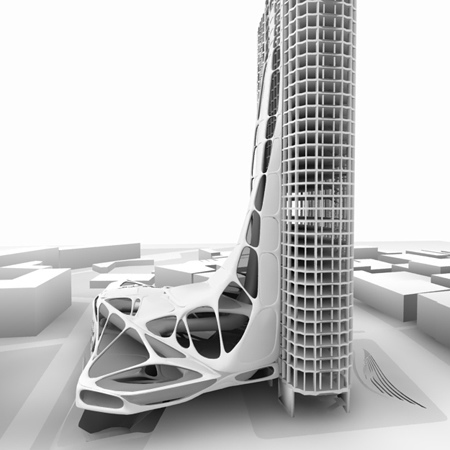Urban Lobby is a research project by architects MRGD, that combines infrastructure and architecture for a speculative redevelopment of the Centre Point office tower in central London.
MRGD is a collaboration of young architects Melike Altinisik, Samer Chaumoun and Daniel Widrig.
The project uses Centre Point as a testing ground for their computational tools and design techniques.
Here's some info from MRGD:
--
Project brief
According to Christopher Alexander, compartmentalization and the dissociation of internal elements are potential signs of anarchy and schizophrenia. Fuzzy logic thinking is another step of helping human thought to recognize our environment less as a world of crisp boundaries and disconnections and more as a field of swarming agents with blurred borders.
EMERGED is investigating the potential of fuzzy logic as a loose-fit organizational technique for developing intelligent, flexible and adaptive environments. Seeing the project as a testing ground for its computational tools and design techniques, the team expands its research territory from focusing and systemizing the dynamic hair tool as generative design machine to a larger scale, involving therefore levels of social, cultural and global organizations. The aim set by the team is to demonstrate a wide range of formal, spatial and programmatic organizations, exploring the ideas of form finding and self-organization.
The project will explore ways of producing architectural interventions based on an understanding of the city as a field of dynamics. The team’s primary concern will involve infrastructure as architecture and their impact on the selected confined site and its immediate adjacencies.
This urban lobby is thought to be a continually contested and negotiated transient space, a public living room, a private boardroom, an orientation space, a public and private open space, a subway business lounge, etc. The resultant possibility of lobby-ing is an investigation rooted in creative and critical speculations on how one addresses contemporary modes of urbanity and interfacing. This urban space is also a functional lobby for the sites various companies needing not only more interfaces with outside i.e.: subcontractors, collaborators, customers, consultants, but also an increase of general communication interfacing among partners, directors and employees.
Currently, Centrepoint, an iconic 70s high-rise building in the centre of London, is comprised of a very scattered amalgam of subway entries that link through tangled labyrinths to the subway lines. In addition the density of the urban commercial and retail fabric provides generative architectural opportunities as well as direct resistance for growth and connectivity.
The high pedestrian activity level of Tottenham Court Road and the convergence of millions of commuters at the current Tottenham Court Road transportation hub provide the site with an intricate connectivity problem.
The project carries the ideas of blurred boundaries, interplay and interaction into the building’s interior; different lobbies will be plugged in and distributed along Centrepoint office building’s facade: a scheme that will replace the earlier concept of Atrium and whose primary role is to speed vertical circulation and communication, establishing interim gathering places throughout the building.
Conclusion
The form builds up with the circulation logic based on the hair systems algorithm, followed by a post production phase highlighting the primary arteries which become structural spines and secondary lines that become circulation paths. The form is complemented by a grid logic flowing and producing a secondary system highly driven into the primary. Its a moment of primary and secondary logic modulated along with a skin layer involving additional subsystems fitting together.
This brings this up the discussion of beauty vs. elegance. Both are quite different concepts. One is either beautiful or not. Technique comes to play its major role to transform what is considered not beautiful to beautiful similar to plastic surgery. It allows us to push towards beauty by producing elegance. Elegance is therefore achieved as kind of problem solving process, an ability to articulate complexity, and multiple agendas into a resolution. Its an elaborated condition whereas beauty is a lucky hit; elegance is a resolution of multiple agendas into complex articulated and resolved conditions.
The random production of using force in the hair systems experiments produced the first step of elegance, the use of logics , continuities and algorithms, laws for differentiation, were all part of the first step towards elegance. It really become virtuosity when we no longer use computers and technology but creatively solve the interpolation and inter-articulation into the organic domain a process that happens through evolution and trial and error and cross interpretation of subsystems all leading to production of elegance.
--
Posted by Rose Etherington

